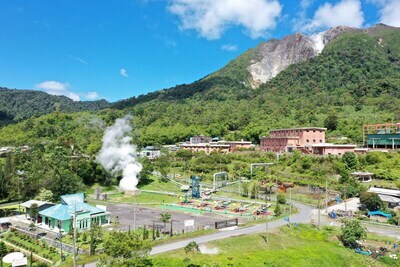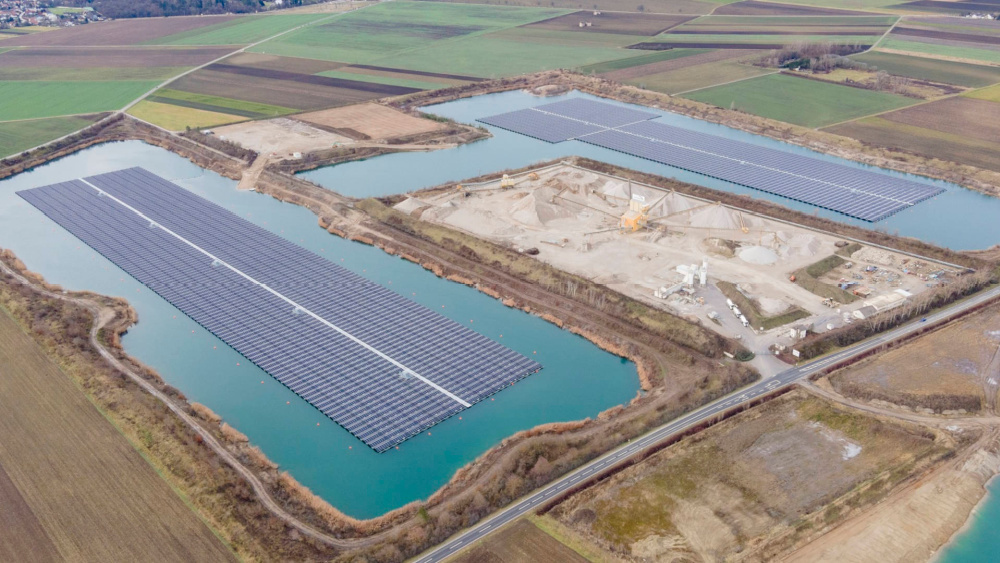Learn more about Hart Energy Conferences
Get our latest conference schedules, updates and insights straight to your inbox.
The energy transformation movement is expected to usher in several firsts for some companies and parts of the world.
The U.S. has proposed its first-ever offshore wind lease sale for the Gulf of Mexico (GoM), continuing its efforts to deploy 30 gigawatts (GW) of offshore wind by 2030.
China’s Sinopec launched its first hydrogen demonstration project in the Inner Mongolia region.
Blue Gem Wind, a joint venture between TotalEnergies and Simple Blue Group, has secured a marine license for its 100 megawatt(MW) Erebus floating wind project in the Celtic Sea offshore Wales. The project will become the country’s first floating wind farm.
Here’s a look at some of this week’s renewable energy news.
Geothermal
Fervo Energy to Develop Integrated Geothermal, DAC Facility
Geothermal power producer Fervo Energy, with support from the Chan Zuckerberg Initiative (CZI), is working to combine geothermal and direct air capture (DAC).
The Houston-headquartered company said on Feb. 23 it plans to design and engineer an integrated geothermal and DAC facility. Carbon-free electricity and heat produced from geothermal energy would be used to operate the facility, lowering CO2 emissions.
“With robust expertise in geosciences and new support from the Chan Zuckerberg Initiative, Fervo is well positioned to drive innovation in carbon removal and demonstrate the natural alignment between geothermal and DAC,” Fervo CEO Tim Latimer said.
In the facility, large fans move air over materials that capture CO2, which is then heated, concentrated, and in many instances, pumped underground, Fervo said in the release.
“Carbon removal technologies are a critical tool for addressing climate change,” said CZI Vice President of Strategic Initiatives Caitlyn Fox. “In order to scale carbon removal, costs need to come down dramatically. Fervo’s unique integration of next-generation geothermal technology with direct air capture creates exciting opportunities to develop rigorous carbon removal at a lower cost while providing a reliable, abundant, carbon-free source of power and heat.”

Masdar Enters Geothermal Sector
Renewable energy giant Masdar, the United Arab Emirates (UAE)-owned renewables company, entered the geothermal sector by investing in Indonesia-based Pertamina Geothermal Energy (PGE), according to a Feb. 24 news release.
The move is the latest by Masdar to increase partnerships in the Asia-Pacific region, where it is also developing a 145 MW floating solar facility and exploring development of up to 1.2 GW of solar capacity in Indonesia.
“Achieving the 1.5 C target set out in the Paris Accords will require humanity to leverage all sources of low-carbon energy, including sources that are currently underutilized, like geothermal,” said Sultan al-Jaber, UAE minister of Industry and Advanced Technology.
PGE said it aims to grow its installed capacity by 600 MW during the next five years to boost Indonesia’s renewable energy mix.
“We look forward to working with Masdar in the areas which complement and grow further our capabilities to be a world class green energy company, with the largest geothermal capacity globally,” PGE CEO Ahmad Yuniarto said.
Indonesia has set out to increase its installed geothermal capacity to 6.2 GW in 2030 from 2.8 GW in 2022.
Hydrogen
Toyota to Supply Hydrogen Fuel Cell Modules to Hyliko
Startup truck company Hyliko will use Toyota’s second-generation hydrogen fuel cell modules for its heavy-duty trucks, Toyota said Feb. 22, as the company grows its zero-emissions fleet.
The partnership comes as Toyota Motor Europe (TME) expands into the commercial vehicle sector, focusing on zero-emissions hydrogen mobility. The company said it is already working with multiple truck partners to integrate its fuel cell technology in heavy-duty transport.
“While the lower mass of hydrogen systems allows for heavier payload, the fast refueling of hydrogen is also essential for heavy commercial transport with high utilization,” Toyota said. “Commercial trucks usage patterns and their demand for larger volumes of hydrogen position them as key contributors in developing sustainable infrastructures.”
France-based Hyliko plans to offer tractors and straight trucks each with two Toyota hydrogen fuel cell modules. The company is also working on building green hydrogen infrastructure, including fuel production, storage and distribution, the release stated.

Nikola, E.ON, Richter Group Partner to Decarbonize Truck Fleets
Nikola and E.ON will supply green hydrogen, refueling infrastructure and hydrogen-powered trucks to the Richter Group, according to a Feb. 22 news release.
The logistics service company seeks to transition its entire fleet to Nikola Tre hydrogen electric trucks over the next four years to five years, the release stated. The initial order is for 20 Nikola Tre hydrogen electric trucks scheduled for delivery in 2024. The company is also working with its logistics partners to transition fleets.
“This letter of intent is just the beginning,” said Richter Group CEO Sylvio Richter. “Through our technology subsidiary Sundronix GmbH, Richter Group will be working with Nikola and E.ON on technological solutions for the design and construction of a 700-bar refueling infrastructure, hydrogen transport logistics, and hydrogen supply.”
As part of the agreement, E.ON will provide the green hydrogen and develop the refueling infrastructure, while Nikola will manufacture the trucks via its joint venture with Iveco Group.
Sinopec Launches Green Hydrogen-coal Chemical Project in Inner Mongolia
Chinese state-controlled oil giant Sinopec said on Feb. 22 it has launched its first hydrogen demonstration project in the Inner Mongolia region.
The company has invested about $827 million in the project and estimates annual production capacity of 30,000 tons of green hydrogen and 240,000 tons of green oxygen, it said in a statement.
RNG
Shell Completes $2 Billion Acquisition of Europe’s Largest RNG Producer
Shell Petroleum NV, a subsidiary of Shell Plc, has completed the previously-announced acquisition of European renewable natural gas (RNG) producer Nature Energy Biogas and now owns 100% of its shares, Shell said in a Feb. 20 press release.
Nature Energy is the largest producer of RNG in Europe and has a portfolio including operating plants, feedstock supply and infrastructure and renewable natural gas plant technology. The acquisition backs Shell’s plan of building a global integrated RNG value chain and low-carbon offerings across multiple sectors.
Nature Energy’s first biogas plant was established in Denmark in 2015, growing to the current 14 operating plants with 2022 production of approximately 6.5 million MMBtu/year (3,000 boe/d).
The Nature Energy acquisition will add to Shell’s already established RNG business in North America, which has an operational site and three more under construction, the company said. The deal also adds 30 new plant projects in Europe and North America to Shell’s RNG portfolio, with more than a third in medium to late development stages and is expected to deliver 9.2 million MMBtu/year – about 4,400 boe/d by 2030.
Chesapeake Utilities to Develop Florida RNG Facility
FPU Renewables LLC, a subsidiary of Chesapeake Utilities Corp., will construct, own and operate a dairy manure renewable natural gas (RNG) facility, according to a Feb. 21 press release.
Located in Madison County, Florida, the project will capture and clean methane from cow manure produced at the Full Circle Dairy facility and create approximately 100,000 dekatherms (1,116 mt) of RNG annually. Chesapeake calculates that the amount of greenhouse gas emissions saved is equivalent to taking 6,012 gasoline-powered passenger vehicles off the road for a year.
“We continue to look for ways to displace more carbon-intensive fuels, and we’re working hard to develop waste-to-energy production facilities, and associated infrastructure, that improve agricultural conditions in Florida and other service areas,” president and CEO Jeff Householder said.
“Collaborations such as the one with Full Circle Dairy are continuing to move both the energy and agricultural industries toward a more sustainable future.”
First RNG injection is expected to occur in 2024. Chesapeake will invest $22 million in the project. The company is also looking for additional opportunities to invest in bringing produced RNG to market and other offtake opportunities.
Full Circle Dairy, operating since 2006, currently recycles manure produced as fertilizer to be used in the fields that grow feed for its herds.
Solar

ECOwind, EVN Bring Floating Solar Plant Online in Austria
ECOwind, a subsidiary of German renewables developer BayWa r.e., has installed a new floating solar power plant in Austria, the company said Feb. 21.
Located in Grafenwörth, Austria, the 24.5-MW plant has about 45,304 solar modules spread across 34 acres that were once a sand and gravel pit on two lakes, BayWay r.e. said on its website. ECOwind plans to produce 26,700 MWh of green electricity per year, enough to supply about 7,500 Austrian households.
Benedikt Ortmann, BayWa r.e.’s global director of solar projects, said the technology has an important role in the clean energy revolution.
“It creates a new function for otherwise unused water surfaces. With this turnkey floating-PV project, we have brought incremental improvements to our already cutting-edge systems in the Netherlands,” said Ortmann. “Together with EVN and our Austrian subsidiary ECOwind, we managed to install the plant in record time – without compromising on environmental protection.”
The companies are touting the project as the largest of its kind in Austria and Central Europe.
AEP, Lightsource BP Sign PPA Indiana Solar Project
Lightsource BP and American Electric Power subsidiary AEP Energy Partners have signed a power purchase agreement for 188-MW solar project near South Bend, Indiana, according to a Feb. 23 news release.
“This power purchase agreement is a great example of how energy buyers with sustainability goals such as AEP Energy Partners can work with us to spur the buildout of new solar projects that will improve the health and energy security of communities across America while helping strengthen local economies,” Kevin Smith, Lightsource BP's CEO of the Americas, said in the release.
The solar farm, dubbed Honeysuckle Solar, is designed to generate enough electricity to power 27,000 homes and reduce CO2 emissions by 204,000 metric tons per year, said Lightsource BP.
With South Bend-based Inovateus Solar LLC as the construction contractor, building of the facility has already begun. Lightsource BP will finance, build, own and operate the solar farm, as well as sell solar energy generated at the facility to AEP. Commercial operations are scheduled to start in 2024, according to the press release.
TIM, Enel X Partner to Develop Solar Plant in Italy
Telecom Italia (TIM) and Enel X signed a partnership on Feb. 20 to develop a solar plant in central Italy, allowing TIM to produce renewable energy and cut its CO2 emissions.
The plant will be installed at the former phone monopoly’s “La Figuretta” site in the Tuscan city of Pisa and will be managed by an Enel division focused on energy efficiency.
The plant will produce over 1.63 GWh per year, saving about 740,000 kilos of CO2 every year, TIM said in a news release, adding the renewable energy produced will be equivalent to that required to power a village of around 600 households.
The companies aim to extend their partnership to other plants that Italy’s biggest phone group is planning to develop, TIM added.
Under its energy strategy, TIM aims to achieve carbon neutrality by 2030.
Wind
Blue Gem Wind JV Secures Marine License for Erebus Floating Wind
TotalEnergies and Simple Blue Group’s joint venture Blue Gem Wind has secured a marine license for its 100 MW Erebus floating wind project in the Celtic Sea offshore Wales.
The project, located about 40 km off the Pembrokeshire coastline, will become the country’s first floating wind farm. With seven 14 MW turbines on WindFloat floating platforms, the wind farm is expected to power more than 93,000 homes and save more than 151,700 tonnes of carbon emissions annually.
“We look forward to taking the next steps towards FID, COD and green electricity production,” Hugh Kelly, co-founder and group managing director at Simply Blue Group, said on Feb. 23.
Kelly added that “Erebus and projects like it are critical components in the race to secure supply chain opportunities and reduce the cost of floating wind as quickly as possible. With the marine license granted, there is just one more piece of the puzzle to secure.”
US Proposes First Offshore Wind Lease Sale in Gulf of Mexico
The U.S. has proposed its first-ever offshore wind lease sale for the Gulf of Mexico (GoM), continuing its efforts to deploy 30 GW of offshore wind by 2030.
The move, announced on Feb. 22, came as the Biden-Harris administration also took steps to grow the nation’s floating wind sector by launching an offshore wind transmission study focused on the West Coast, expanding an offshore wind R&D consortium and developing an offshore wind operations and maintenance roadmap.
The proposed GoM wind lease sale, home to vast oil and gas production, would open 102,480 acres offshore Lake Charles, Louisiana, and two areas offshore Galveston, Texas— one for 102,480 acres and the other for 96,786 acres—for wind development. Combined, the areas could power nearly 1.3 million homes with clean energy, according to the Interior Department.
If the Bureau of Ocean Energy Management proceeds with the sale, a final sale notice will be published at least 30 days before the sale announcing the sale’s time, date and qualifying companies.
Denmark to Issue Offshore Wind Tenders
Denmark will issue public tenders for offshore wind projects this year and may resume reviewing applications that had been suspended over worries of breaching EU state aid law, the country's energy minister said on Feb. 21.
The Nordic country, home to industry leaders Vestas and Ørsted, will issue public tenders for 9 GW of offshore wind this year, as part of its goal to increase capacity fivefold by 2030, Minister of Climate, Energy and Utilities Lars Aagaard said Feb. 21.
In addition to issuing public tenders, Denmark also allows energy companies to submit unsolicited applications to install renewable energy projects under a so-called “open door scheme.”
The Danish Energy Agency this month suspended reviewing applications to install new offshore wind farms and other renewable energy projects under the scheme, citing a possible conflict with EU law. The move had drawn criticism from the wind industry.
Aagaard said the current suspension was based on worries Denmark might breach EU state aid rules by giving energy companies the right to install wind farms on the Danish seabed without demanding payment for those rights. Danish authorities are currently working to resolve the matter with the European Commission.
Hart Energy staff and Reuters contributed to this article.
Recommended Reading
Sinopec Brings West Sichuan Gas Field Onstream
2024-03-14 - The 100 Bcm sour gas onshore field, West Sichuan Gas Field, is expected to produce 2 Bcm per year.
Chevron Hunts Upside for Oil Recovery, D&C Savings with Permian Pilots
2024-02-06 - New techniques and technologies being piloted by Chevron in the Permian Basin are improving drilling and completed cycle times. Executives at the California-based major hope to eventually improve overall resource recovery from its shale portfolio.
US Gas Rig Count Falls to Lowest Since January 2022
2024-03-22 - The combined oil and gas rig count, an early indicator of future output, fell by five to 624 in the week to March 22.
E&P Highlights: April 15, 2024
2024-04-15 - Here’s a roundup of the latest E&P headlines, including an ultra-deepwater discovery and new contract awards.
For Sale, Again: Oily Northern Midland’s HighPeak Energy
2024-03-08 - The E&P is looking to hitch a ride on heated, renewed Permian Basin M&A.





